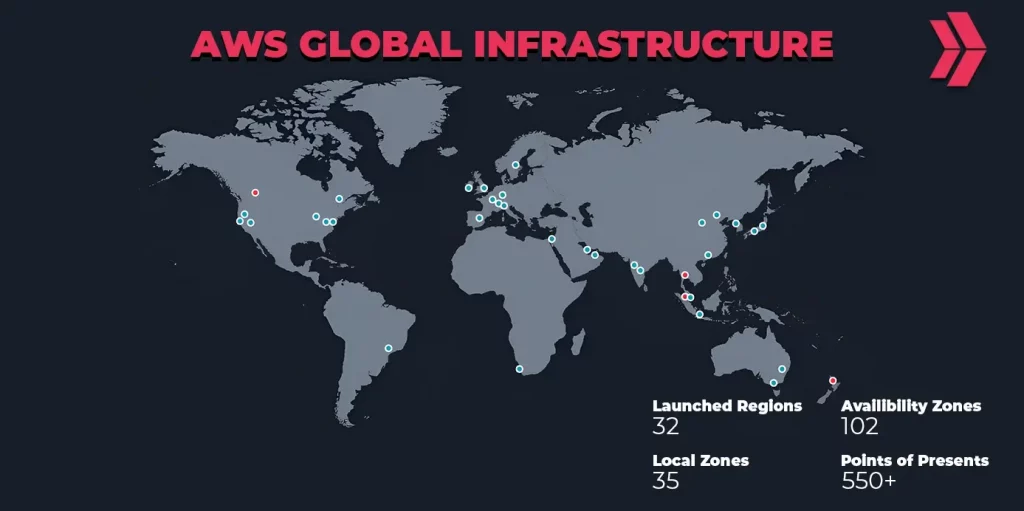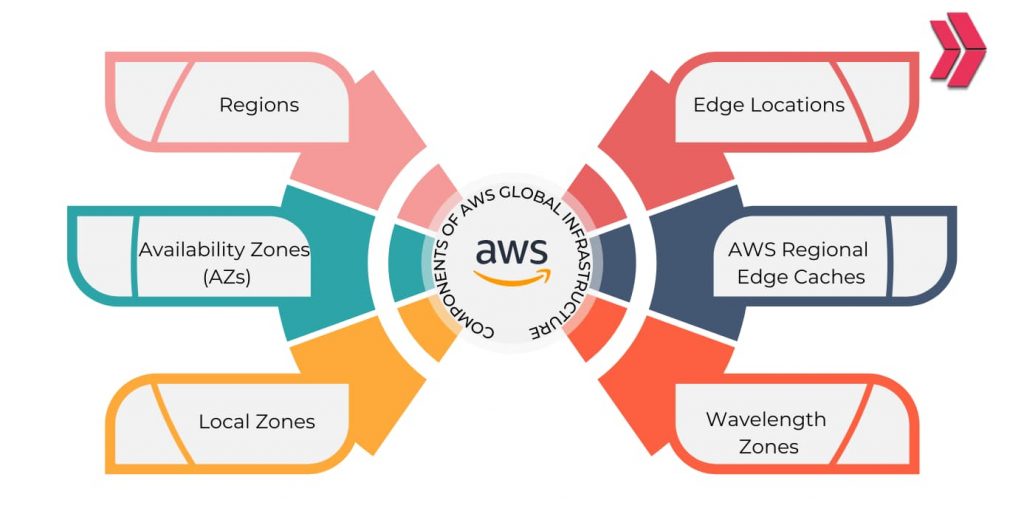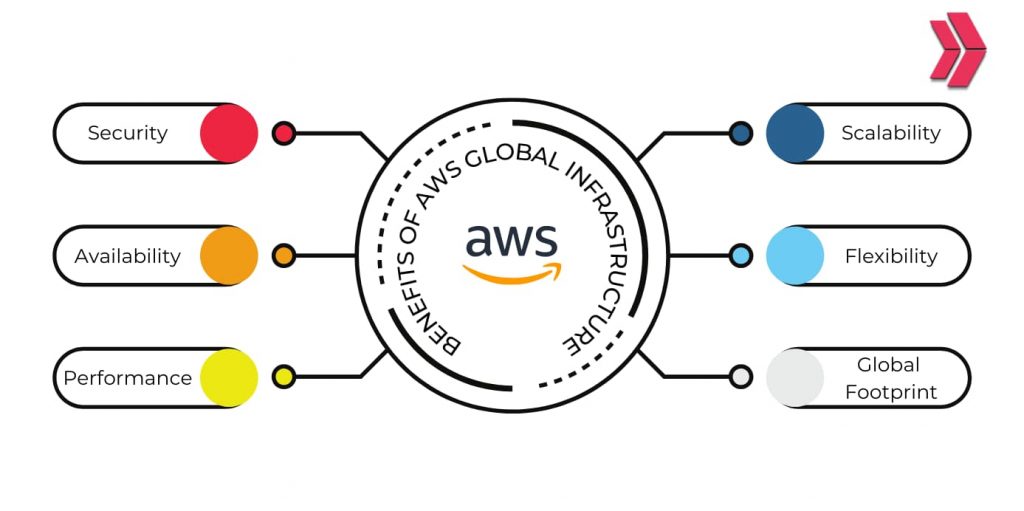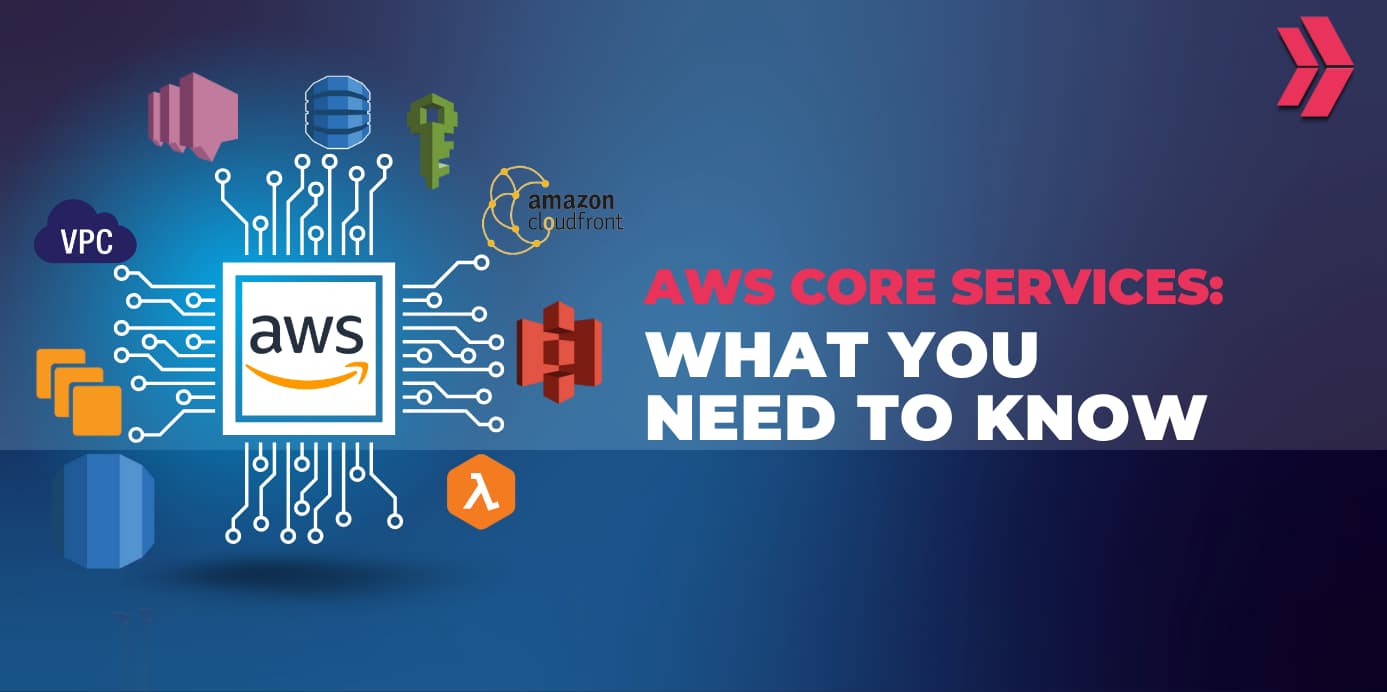The AWS Global Cloud Infrastructure stands as one of the most expansive cloud services, providing a comprehensive array of more than 200 fully-featured services accessible from data centers distributed across the world. Learning about the AWS Global Infrastructure opens the door to a modern world of cloud technology. Understanding this digital world becomes possible as you delve deeper into the many powerful tools and services that Amazon Web Services (AWS) offers worldwide.
The key components of the AWS Global Cloud Infrastructure are Regions, Availability Zones, Edge Locations, Wavelength Zones, and Regional Edge Caches. Exploring these key components provides a comprehensive understanding of how the network is structured and optimized for seamless performance and reliability.
In this blog post, we will explore AWS’s Global Infrastructure. If you’re a cloud enthusiast looking to earn AWS certifications like AWS Certified Cloud Practitioner or AWS Solution Architect, this is where you should begin your adventure.

What is AWS Global Infrastructure?
The AWS Global Infrastructure is a vast network of data centers and resources strategically located throughout the world to provide cloud services. The infrastructure comprises multiple interconnected components, such as Regions, Availability Zones, Local Zones, and Wavelength Zones.
AWS Global Infrastructure’s main component is data centers called Availability Zones (AZ). AZ’s are isolated locations within AWS Regions. The AWS Global Infrastructure Map currently includes 102 Availability Zones spread across 32 geographic regions globally. Moreover, plans are underway to expand with an additional 12 Availability Zones and 4 more AWS Regions, covering countries like Canada, Malaysia, New Zealand, and Thailand.
Additionally, AWS offers 35 Local Zones and 29 Wavelength Zones, catering to the needs of ultralow latency applications. Local Zones extend AWS services to select metropolitan areas, allowing for proximity to end-users and reduced latency. On the other hand, telecommunication providers collaborate in designing Wavelength Zones to bring AWS services even closer to 5G networks, thereby enhancing the performance of latency-sensitive applications.
What are the Key Components of AWS Global Infrastructure?
The AWS Global Infrastructure represents a highly distributed and robust ecosystem of data centers, ensuring global coverage, reliability, and performance for a wide array of cloud-based services and applications. Here is the 6 components of AWS Global Infrastructure:
- Regions
- Availability Zones (AZs)
- Local Zones
- Edge Locations
- AWS Regional Edge Caches
- Wavelength Zones

AWS Regions
An AWS Region is a distinct geographical area worldwide where a collection of data centers is clustered. This model incorporates multiple Availability Zones and physically and logically separate logical data center groups. Each AWS Region comprises at least three such Availability Zones, ensuring geographic redundancy and high availability.
AWS Regions and Availability Zones are not the same. AWS Regions are the larger geographical areas where data centers are located, while Availability Zones are subsets within those regions. We will discuss AZs deeply in the next part.
AWS operates in several geographic regions, including North America, South America, Europe, China, Asia Pacific, South Africa, and the Middle East.
AWS Availability Zones
People often refer to Availability Zones (AZs) in AWS as data center facilities. Each Availability Zone is a physically separated data center with its own power and infrastructure. AWS has strategically designed these Availability Zones to provide redundancy and resiliency for applications and services.
AWS Availability Zones have their own power, cooling, and networking infrastructure. Deploying resources across multiple Availability Zones ensures that if one AZ experiences issues or downtime, it enables the others to continue operating, thereby enhancing the overall resilience of applications hosted on the AWS platform.
Physical distances are important when comparing the distance between an AWS Region and its corresponding AZ. This separation helps minimize the impact of natural disasters or localized incidents. A significant distance physically separates Availability Zones in AWS. It’s important to note that while the distance between AZs is substantial, all AZs within a given AWS Region remain within 100 kilometers (approximately 60 miles) from each other.
Here is the full list of AWS data center locations in all regions:
Europe / Middle East / Africa
- 11 Geographic Regions
- 33 Availability Zones
- 39 Edge Network locations
- 2 Regional Edge Cache locations
Availability Zones:
Bahrain (3), Cape Town (3), Frankfurt (3), Ireland (3), London (3), Milan (3), Paris (3), Spain (3), Stockholm (3), Zurich (3), and UAE (3)
North America
- 7 Geographic Regions
- 25 Availability Zones
- 44 Edge Network locations
- 2 Regional Edge Cache locations
Availability Zones:
N. Virginia (6), Ohio (3), N. California (3), Oregon (4), US-East (3), US-West (3), Central (3)
South America
- 1 Geographic Regions
- 3 Availability Zones (in São Paulo)
- 4 Edge Network locations
- 1 Regional Edge Cache locations
Asia Pacific and China
- 12 Geographic Regions
- 38 Availability Zones
- 34 Edge Network locations
- 5 Regional Edge Cache locations
AWS Local Zones
AWS Local Zones are a part of the AWS Global infrastructure that brings cloud services locally to certain areas with a high concentration of users and applications. Essentially, these Local Zones form a subset of AWS Availability Zones, but they situate themselves in close proximity to specific metropolitan areas.
Local Zones allow customers to deploy applications that require low latency to end-users or specific resources in those geographic areas. They are particularly useful for applications that require real-time processing, such as gaming, interactive multimedia, and financial services, where reducing latency is critical for a seamless user experience.
AWS Local Zones Locations:
Local Zones are available in 33 metropolitan areas around the world, where 16 of them are located in the US (specific names not provided), and 17 of them are located outside of the US. Here are 17 Local Zones located outside the US:
- Lagos
- Auckland
- Santiago
- Bangkok
- Kolkata
- Copenhagen
- Hamburg
- Helsinki
- Lima
- Muscat
- Perth
- Querétaro
- Taipei
- Warsaw
- Delhi
- Buenos Aires
- Manila
Additionally, AWS plans to broaden Local Zones to encompass 19 additional locations spanning 16 countries:
- Australia
- Austria
- Belgium
- Brazil
- Canada
- Colombia
- Czech Republic
- Germany
- Greece
- India
- Kenya
- Netherlands
- Norway
- Portugal
- South Africa
- Vietnam
AWS Edge Locations
AWS Edge Locations are endpoints for Amazon Web Services’ CloudFront service. They are strategically distributed data centers situated in various areas around the world. These Edge Locations act as caching servers that store copies of frequently accessed content, such as images, videos, web pages, and other static files, closer to the end users.
The Edge Location closest to the client receives requests for content distributed via CloudFront. This reduces latency and improves the overall performance of the application or website if the content already exists at that Edge Location. If the content still needs to be cached, the Edge Location retrieves it from the origin server (such as an Amazon S3 bucket or a custom origin) and caches it for subsequent requests.
AWS Regional Edge Caches
Like edge locations, Regional Edge Caches are CloudFront service sites strategically placed worldwide near your viewers. They deliver content directly to viewers between your origin server and global edge locations.
Regional edge caches assist with many sorts of material, especially with content that becomes less popular over time. Examples are user-generated material, e-commerce assets, news, and other content that may rapidly gain popularity.
Wavelength Zones
AWS Wavelength is an Amazon Web Services (AWS) service that brings cloud services to the edge of 5G networks. It supports real-time gaming, augmented reality (AR), virtual reality (VR), video streaming, and other applications that require ultra-low latency and high bandwidth connectivity.
A Wavelength Zone is essentially a specialized infrastructure deployment within a data center run by a telecommunications provider.
These zones are strategically placed in close proximity to 5G base stations, allowing for a direct connection between the AWS resources and the 5G network. The proximity minimizes latency for applications requiring instant responses.
With Wavelength, developers can run their applications and workloads on AWS infrastructure located at the edge of the 5G network, combining the benefits of both AWS services and high-speed, low-latency 5G connectivity.
What are the 6 benefits of AWS Global Infrastructure?
The AWS Global Infrastructure offers 6 key benefits to businesses and organizations that leverage its services, as mentioned on the AWS website: security, availability, performance, scalability, flexibility, and global footprint.
Security
AWS offers robust security measures, including encryption and constant monitoring. You maintain control over your data with encryption, movement, and retention options.
Availability
AWS ensures the utmost network availability among cloud providers. Each region is isolated and divided into multiple Availability Zones (AZs). If one AZ experiences an issue, other AZs can continue to operate without interruption.
Performance
Low latency, minimal packet loss, and high network quality are all characteristics of AWS Global Infrastructure.
Scalability
AWS enables flexible scaling of resources, eliminating over-provisioning. You can instantly adjust resources based on business needs, rapidly deploying hundreds or thousands of servers.
Flexibility
You have the freedom to choose how and where to run workloads, utilizing the same network, control plane, APIs, and services. Options include global AWS Regions, AWS Local Zones, AWS Wavelength for low latency, and AWS Outposts for on-premises deployment.
Global Footprint
AWS has an extensive global infrastructure presence. You can choose to select technology infrastructure close to your intended users, ensuring ideal assistance for a wide range of applications, from those requiring high throughput to those requiring low-latency performance.
These benefits empower businesses to build, scale, and operate applications efficiently while leveraging a secure and reliable global cloud infrastructure provided by AWS.

What are Essential AWS Certifications and Courses to Learn AWS Global Infrastructure?
To become proficient in understanding and working with AWS Global Infrastructure, you can pursue specific AWS certifications and courses that cover relevant concepts, technologies, and best practices. Here are the top 3 essential AWS certifications and courses that can help you learn about AWS Global Infrastructure: AWS Cloud Practitioner Certification, AWS Certified Solutions Architect – Associate, and AWS Certified Solutions Architect – Professional.
AWS Cloud Practitioner Certification
The AWS Certified Cloud Practitioner certification provides a solid overview of AWS services, pricing models, architecture, security, and the overall benefits of cloud computing. This certification is ideal for beginners who are new to cloud technology and want to grasp the fundamental concepts, services, and benefits of cloud computing.
The AWS Certified Cloud Practitioner certification is a great starting point for anyone looking to build a foundational understanding of Amazon Web Services and cloud computing concepts. It does not dive into the technical details of specific AWS services.
AWS Certified Solutions Architect – Associate
AWS Certified Solutions Architect – Associate certification covers a broad range of AWS services and architectural best practices, including designing and deploying applications on a global scale using multiple regions and Availability Zones.
AWS Certified Solutions Architect – Associate certification is ideal for individuals who want to showcase their expertise in architecting solutions using AWS services, including global infrastructure-related ones.
AWS Certified Solutions Architect – Professional
The AWS Certified Solutions Architect – Professional certification is an advanced-level certification offered by Amazon Web Services (AWS). AWS Cloud professionals with extensive experience and expertise in designing and deploying complex applications are ideal candidates for this program.
Building on the associate-level certification, AWS Certified Solutions Architect – Professional certification goes deeper into advanced architectural concepts, including designing highly available and fault-tolerant systems across a global infrastructure.
How to learn AWS?
AWS provides comprehensive documentation on its global infrastructure, including networking, regions, Availability Zones, and global services. Reading AWS whitepapers related to networking and global infrastructure is also highly recommended.
Remember that hands-on experience and practical projects are crucial to truly understanding and mastering AWS Global Infrastructure. Consider working on real-world projects, setting up multi-region architectures, and experimenting with AWS services to gain practical expertise. Moreover, remain on top of any new AWS courses that may emerge to enhance your knowledge of AWS Global Infrastructure further.




